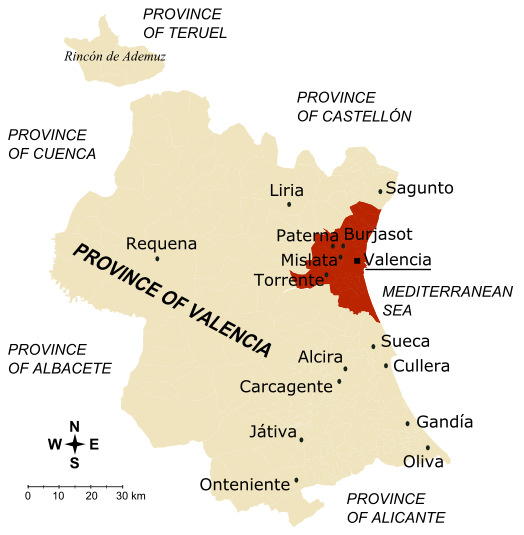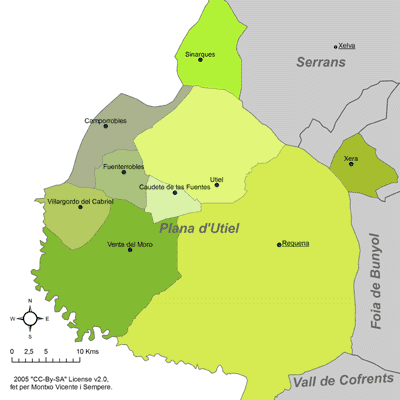|
Manchuela Conquense
Manchuela or La Manchuela ("lesser La Mancha") is a '' comarca'' located in Castile-La Mancha and Valencian Community, Spain. Historical comarca The historical Manchuela comarca included the municipalities of Tarazona de la Mancha and Villalgordo del Júcar, and the Requena-Utiel comarca which had been part of the Cuenca Province until 1851 and is now part of the province of Valencia, Valencian Community, except for Mira. This comarca has been traditionally a place of wheat, olive and wine growers, along with some cattle rearing. There are two wine Designations of Origin in the comarca, Manchuela DO and Ribera del Júcar DO. Present-day comarca The present-day Manchuela comarca is divided between Manchuela Albaceteña in Albacete Province, the Manchuela Conquense in Cuenca Province and the Valencian Manchuela (Requena-Utiel) in the Valencia Province. The Júcar River cuts across the high plateau of La Meseta forming deep gorges ''(Hoces del Júcar)'' offerin ... [...More Info...] [...Related Items...] OR: [Wikipedia] [Google] [Baidu] |
Comarcas Of Castile-La Mancha
In Spain, a ''comarca'' (, sing. ''comarca'') is either a traditional territorial division without any formal basis, or a group of municipalities, legally defined by an autonomous community for the purpose of providing common local government services. In English, a comarca is equivalent to a district, county, area or zone. Legally defined comarcas The large majority of legally defined comarcas are in Catalonia (42) and Aragon (33)), and are regulated by law and are governed by a comarcal council with specified powers. There are seven comarcas formally registered in Basque Country and one in Castile and León. In Andalusia and Asturias, comarcas are defined by law but lack any defined function. Informal comarcas In other regions, comarcas are traditional or historical or in some cases, contemporary creations designed for tourism promotions. In some other cases (e.g. La Carballeda) a comarca may correspond to a natural area, like a valley, river basin and mountainous area, ... [...More Info...] [...Related Items...] OR: [Wikipedia] [Google] [Baidu] |
Ribera Del Júcar
Ribera del Júcar is a Spanish Denominación de Origen Protegida (DOP) for wines located in the province of Cuenca ( Castile-La Mancha, Spain) along the banks of the River Júcar and covers 7 municipalities. History Grapes have been grown and wine produced in this area for centuries but DOP status was acquired only in 2003, making Ribera de Júcar one of the youngest DOPs in Spain. Climate The climate is Mediterranean continental with sharp contrasts between summer and winter temperatures. The average temperature is 24°C in summer and 5°C in winter. Rainfall is sparse, around 350 mm/year. Soil The area covered by the DOP is located on a plateau of pebbly soil at an altitude of 750 m above sea level along the banks of the River Júcar. The drainage is good in that rainwater can penetrate through the top pebbly layer down to the clay subsoil where it is retained. Grape varieties The authorised varieties are: * Red: Cencibel / Tempranillo, Cabernet Sauvignon, Merlot, Sy ... [...More Info...] [...Related Items...] OR: [Wikipedia] [Google] [Baidu] |
Manchuela DO
Manchuela is a Spanish Denominación de Origen Protegida (DOP) for wines located in the historical Manchuela comarca, in the east of the provinces of Albacete and Cuenca ( Castile-La Mancha, Spain) between the valleys of the Rivers Júcar and Cabriel. It was originally part of a much larger La Mancha DOP and became a separate DOP in 2004. It is surrounded on three sides by other DOPs: La Mancha to the west, Utiel-Requena to the east and Jumilla to the south. History La Manchuela DOP is the seventh DOP to be created in the region of Castile-La Mancha. It includes over seventy municipalities, including Albacete itself and Motilla del Palancar in Cuenca. Climate The climate is continental (long hot dry summers, cold winters) influenced by the nocturnal moisture bearing winds from the Levant, which help keep the mean annual temperature down to 25°C. Temperatures in winter rarely fall low enough to cause frost. Humidity is very low and virtually no rainfall between the months of M ... [...More Info...] [...Related Items...] OR: [Wikipedia] [Google] [Baidu] |
Wine
Wine is an alcoholic drink typically made from fermented grapes. Yeast consumes the sugar in the grapes and converts it to ethanol and carbon dioxide, releasing heat in the process. Different varieties of grapes and strains of yeasts are major factors in different styles of wine. These differences result from the complex interactions between the biochemical development of the grape, the reactions involved in fermentation, the grape's growing environment (terroir), and the wine production process. Many countries enact legal appellations intended to define styles and qualities of wine. These typically restrict the geographical origin and permitted varieties of grapes, as well as other aspects of wine production. Wines not made from grapes involve fermentation of other crops including rice wine and other fruit wines such as plum, cherry, pomegranate, currant and elderberry. Wine has been produced for thousands of years. The earliest evidence of wine is from the Caucasus ... [...More Info...] [...Related Items...] OR: [Wikipedia] [Google] [Baidu] |
Olive
The olive, botanical name ''Olea europaea'', meaning 'European olive' in Latin, is a species of small tree or shrub in the family Oleaceae, found traditionally in the Mediterranean Basin. When in shrub form, it is known as ''Olea europaea'' 'Montra', dwarf olive, or little olive. The species is cultivated in all the countries of the Mediterranean, as well as in Australia, New Zealand, North and South America and South Africa. ''Olea europaea'' is the type species for the genus ''Olea''. The olive's fruit, also called an "olive", is of major agricultural importance in the Mediterranean region as the source of olive oil; it is one of the core ingredients in Mediterranean cuisine. The tree and its fruit give their name to the plant family, which also includes species such as lilac, jasmine, forsythia, and the true ash tree. Thousands of cultivars of the olive tree are known. Olive cultivars may be used primarily for oil, eating, or both. Olives cultivated for consumption ar ... [...More Info...] [...Related Items...] OR: [Wikipedia] [Google] [Baidu] |
Wheat
Wheat is a grass widely cultivated for its seed, a cereal grain that is a worldwide staple food. The many species of wheat together make up the genus ''Triticum'' ; the most widely grown is common wheat (''T. aestivum''). The archaeological record suggests that wheat was first cultivated in the regions of the Fertile Crescent around 9600 BCE. Botanically, the wheat kernel is a type of fruit called a caryopsis. Wheat is grown on more land area than any other food crop (, 2014). World trade in wheat is greater than for all other crops combined. In 2020, world production of wheat was , making it the second most-produced cereal after maize. Since 1960, world production of wheat and other grain crops has tripled and is expected to grow further through the middle of the 21st century. Global demand for wheat is increasing due to the unique viscoelastic and adhesive properties of gluten proteins, which facilitate the production of processed foods, whose consumption is inc ... [...More Info...] [...Related Items...] OR: [Wikipedia] [Google] [Baidu] |
Province Of Valencia
Valencia ( ca-valencia, València) is a province of Spain, in the central part of the autonomous Valencian Community. Of the province's over 2.5 million people (2018), one-third live in the capital, Valencia, which is also the capital of the autonomous community and the 3rd biggest city in Spain, with a metropolitan area of 2,522,383 people it is also one of the most populated cities of Southern Europe.http://appsso.eurostat.ec.europa.eu/nui/show.do?dataset=met_pjanaggr3&lang=en There are 265 municipalities in the province. History Although the Spanish Constitution of 1812 loosely created the province of València, a stable administrative entity does not arise until the territorial division of Spain in 1833, remaining today without major changes. The Provincial Council of Valencia dates from that period. After the Valencian Statute of Autonomy of 1982, the province became part of the Valencian Community. Valencian and Spanish are the official languages. Geography It is borde ... [...More Info...] [...Related Items...] OR: [Wikipedia] [Google] [Baidu] |
Cuenca Province (Spain)
Cuenca is one of the five provinces of the autonomous community of Castilla-La Mancha. It is located in the eastern part of this autonomous community and covers 17,141 square km. It has a population of 203,841 inhabitants -- the least populated of the five provinces. Its capital city is also called Cuenca. Geography The province is bordered by the provinces of Valencia (including its exclave Rincón de Ademuz), Albacete, Ciudad Real, Toledo, Madrid, Guadalajara, and Teruel. The northeastern side of the province is in the mountainous Sistema Ibérico area. 211,375 people (2007) live in the province. Its capital is Cuenca, where nearly a quarter of the population live, some 52,980 people. There are 238 municipalities in Cuenca. Other populous towns and municipalities include Tarancón, San Clemente, Quintanar del Rey, Huete, Villanueva de la Jara, Motilla del Palancar, Mota del Cuervo, La Almarcha and Las Pedroñeras. History In 1851 Cuenca lost Requena-Utiel to the n ... [...More Info...] [...Related Items...] OR: [Wikipedia] [Google] [Baidu] |
Requena-Utiel
La Plana de Utiel-Requena is a ''comarca'' currently in the province of Valencia Valencia ( va, València) is the capital of the Autonomous communities of Spain, autonomous community of Valencian Community, Valencia and the Municipalities of Spain, third-most populated municipality in Spain, with 791,413 inhabitants. It is ..., Valencian Community, Spain. Historically, the ''comarca'' was part of Castile (historical region), Castile and formed part of the province of Cuenca in the 1833 territorial division of Spain, 1833 provincial division of Javier de Burgos. As such, its inhabitants have been traditionally monolingual in Spanish language, Spanish and not Valencian language, Valencian- speakers. However, in 1851 it was merged into the province of Valencia, as a result of its commercial ties with the city of Valencia, Spain, Valencia. Chera, Valencia, Chera, now officially included in Requena-Utiel according to the current administrative division pattern of the Valencian Com ... [...More Info...] [...Related Items...] OR: [Wikipedia] [Google] [Baidu] |





.jpg)
